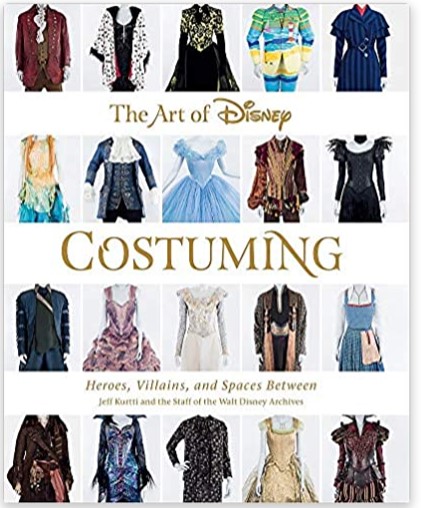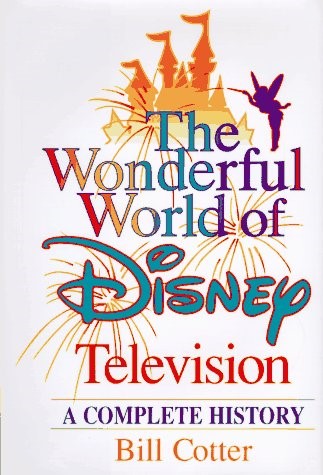Category — A Friday Visit with Jim Korkis
A Friday Visit with Jim Korkis: Washington Irving in Walt Disney World
Welcome back to Fridays with Jim Korkis! Jim, the dean of Disney historians, writes about Walt Disney World history every Friday on yourfirstvisit.net.
WASHINGTON IRVING IN WALT DISNEY WORLD
By Jim Korkis
The Legend of Sleepy Hollow is a short story by American writer Washington Irving that was first published in 1820. It tells the timeless tale of schoolteacher Ichabod Crane’s memorable encounter with a Headless Horseman who rides on Halloween night looking for a head to replace the one he lost to a flying cannonball. Irving is actually buried in Sleepy Hollow Cemetery.
When The Legend of Sleepy Hollow (1949) was first run on the weekly Disney television show on October 26th, 1955, to fill out the hour, a new fourteen minute animated segment about the life of author Washington Irving was included.
The new prologue told about Irving’s life and adventures as a child in Manhattan, New York, which included visiting old and abandoned houses that were said to be haunted, and even visiting Sleepy Hollow itself. The prologue also shows Irving’s time as a writer and his trips to different countries of Europe. This animated prologue has unfortunately never been released on any form of home media.
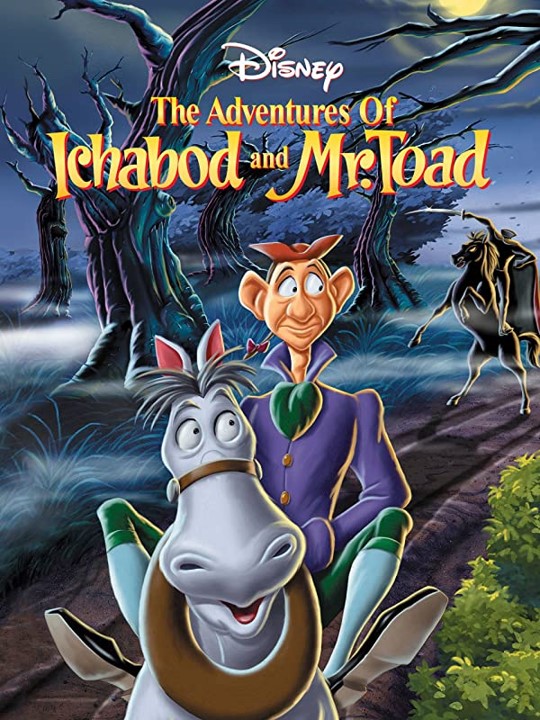
(c) Disney
The Legend of Sleepy Hollow seemed a natural fit for Liberty Square at Walt Disney World, especially since the Haunted Mansion was not in New Orleans as at Disneyland but now resided in the Hudson River Valley which was the location for Irving’s story. The architecture of the mansion reflects that location and time period.
When Liberty Square was being built at the Magic Kingdom in 1970, Imagineer Tony Baxter pitched the idea of a dark ride based on The Legend of Sleepy Hollow to help the transition of the intersection from Fantasyland to Liberty Square. Guests would have ridden in hollowed-out spinning jack-o-lanterns through a variety of scenes from the story until the final dramatic confrontation with the headless horseman.
However the area set aside for that attraction was used for the Yankee Trader shop that eventually became what is today the Memento Mori (“Remember that you will die”) shop opposite the Columbia Harbour House.
The exterior architecture of the Sleepy Hollow food and beverage location at the entrance to Liberty Square is based on the tiny, two-room cottage that writer Irving purchased on ten acres along the banks of the Hudson River in Tarrytown, New York.
Irving spent many years remodeling and expanding the cottage, combining elements of colonial New York architecture and buildings he knew in Scotland and Spain. He named it Sunnyside in 1841, and history shows that it was usually busy with lots of friends and family.
The Sleepy Hollow food and beverage location in Walt Disney World offers a souvenir plastic stein with the image of Ichabod on one side and the Headless Horseman on the other.
When the shop building opposite the Hall of Presidents was converted and reopened February 1996 as Ye Olde Christmas Shoppe, one of the new stores was devoted to music.
Outside the music shop was a sign stating “Music & Voice Lessons by appointment, Ichabod Crane, Instructor”, a profession that Ichabod did to earn some additional money from his regular teaching assignment.
The spooky Headless Horseman rides from Frontierland to Main Street U.S.A. in advance of each performance of Mickey’s “Boo To You” Halloween Parade as part of the separately ticketed Mickey’s Not-So Scary Halloween Party.
Over the decades, the Fort Wilderness Resort and Campground has offered several different experiences where guests can have an encounter with the Headless Horseman during the Halloween season.
So images from Irving’s most famous short story are in evidence throughout Liberty Square, and elsewhere in Walt Disney World, for those who care to take the time to look.
* * * * *
Thanks, Jim! And come back next Friday for more from Jim Korkis!
In the meantime, check out his books, including his new Halloween-appropriate Vault of Walt Volume 9: Halloween Edition, and his other new book, Hidden Treasures of the Disney Cruise Line.
Follow yourfirstvisit.net on Facebook or Twitter or Pinterest!!
October 23, 2020 No Comments
A Friday Visit with Jim Korkis: Who Was Master Gracey?
Welcome back to Fridays with Jim Korkis! Jim, the dean of Disney historians, writes about Walt Disney World history every Friday on yourfirstvisit.net.
WHO WAS MASTER GRACEY?
By Jim Korkis
Yale Gracey was called an “Illusioner” in the days before the term “Imagineer” was officially coined. Many of the more prominent special effects in the Haunted Mansion were the work of Gracey.
Today, if his name is known at all, it is because it is mistakenly believed that “Master Gracey” was the master of the haunted house—thanks to a tombstone in the outside graveyard written by Imagineeer X. Atencio, show writer for the attraction, that declares: “Master Gracey, laid to rest, no mourning please, at his request.”
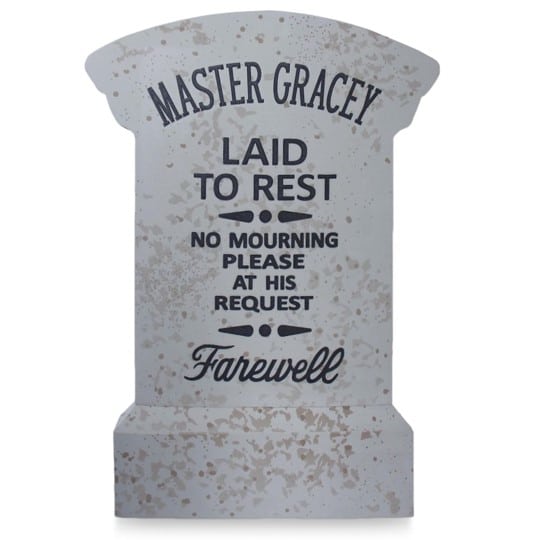
Atencio was trying to offer a tribute to his friend, the boyish Yale Gracey, not make him the owner and master of the house. He was also trying to honor Gracey’s many contributions to the Haunted Mnasion project, especially the fact that his boyhood fondness for magic resulted in some of the illusions in the attraction.
Yale Gracey joined the Disney Studios in 1939 as a layout artist working on Pinocchio and then later animated features including Fantasia. He continued to work on Disney animated films, including doing layouts and backgrounds on most of the Donald Duck shorts directed by Jack Hannah.
Walt Disney had noticed Gracey spending time during his lunch hours with making little gadgets and illusions. Walt was so impressed that Gracey was given a pair of rooms to develop new effects for Disneyland attractions.
Gracey was teamed up with Rolly Crump around 1959 and the two worked on several projects together including early concept work for the Haunted Mansion.
The famous ghosts in the ballroom scene of the Haunted Mansion owe their magic not to holographic projections or, as Imagineer Tony Baxter loves to quip “real ghosts,” but to the “Pepper’s Ghost” illusion that was refined by magician Henry Pepper in 1862 for his stage act. Gracey first encountered this amazing yet simple illusion in his copy of the book The Boy Mechanic, Volume 1, page 52, from 1913.
To demonstrate the effect and how it worked for Walt Disney, Gracey built a working miniature model. It was a box about three feet square. There was a slot at the top of the front side where a viewer could look. Pushing a button the lights come on and the ghosts sweep through the scale model. The model is now housed at the Magic Castle in Southern California.
Gracey built another model of a skeleton ghost playing a pipe organ using the Pepper’s Ghost illusion that was showcased on the Disneyland 10th Anniversary January 3,1965 episode of the Walt Disney’s Wonderful World of Color.
Yale Gracey experimented with using film of Hans Conried’s talking head from the Magic Mirror on the 1956 Disney television show episode Our Unsung Villains and projecting it on a bust of Beethoven. While it didn’t sync exactly, it appeared as if the bust came to life and began talking and encouraged Gracey to develop it even further into the four singing busts in the graveyard.
Imagineer Rock Hall told me in a 2010 interview: “He always said that the best effects were simple effects like finding out that a sculpted face when vacuum formed and viewed from the back seems to follow you. This was an accidental development that Yale discovered and ended up using in the hallway at the Haunted Mansion.”
Yale Gracey was the master of creating things that had never been created before like the fireflies in Disneyland’s Blue Bayou and the fire scene in Pirates of the Caribbean that was so realistic that the fire department insisted it be toned down and have a shut-off switch in case a real fire ever broke out building. It is a shame he is not better known for his many contributions to the Disney theme parks.
* * * * *
Thanks, Jim! And come back next Friday for more from Jim Korkis!
In the meantime, check out his books, including his new Halloween-appropriate Vault of Walt Volume 9: Halloween Edition, and his other new book, Hidden Treasures of the Disney Cruise Line.
Follow yourfirstvisit.net on Facebook or Twitter or Pinterest!!
October 16, 2020 No Comments
A Friday Visit with Jim Korkis: The Art of Disney Costuming
Welcome back to Fridays with Jim Korkis! Jim, the dean of Disney historians, writes about Walt Disney World history every Friday on yourfirstvisit.net.
YOUR PERSONAL DISNEY LIBRARY (33)
By Jim Korkis
- The Art of Disney Costuming by Jeff Kurtti
This month many readers are thinking about Halloween costumes, and some in particular of Disney Halloween costumes. Sometimes people will buy costumes, and other times try to use their own skills and cleverness to piece together an acceptable version of their favorite character for themselves or their children.
So, The Art of Disney Costuming is highly appropriate to review this month. When most Disney fans think of Disney costumes, they probably immediately think of the costumes that appeared in Disney movies (both live-action and animation) and television. Some of those costumes are iconic and are actually trademarked.
For instance, Snow White’s costume is trademarked not just for the actual colors but the proportion of those colors. Since the character is public domain, Disney does not want someone coming up with a character too reminiscent of the Disney version.
Some fans might even think of the costumes for audio-animatronics characters. I remember spending an hour listening to Alice Davis, who had costumed It’s A Small World and Pirates of the Caribbean, regale a group of us with stories about the various challenges.
Because of how they move, different parts of a costume on an audio-animatronics character will wear out more quickly, like the elbows. Also the costume has to be designed so it can be removed since you can’t move the arms and legs to pull off a shirt or pants.
That situation, of course, relates to Walt Disney World but the reason I am doing this review is because this book also touches on cast member costumes. Walt Disney World has one of the largest working wardrobes in the world. Cast members are told that they are not wearing uniforms but are wearing costumes because they are “on stage” and are part of a larger story being told in their area.
I remember when I was a “friend” of Merlin, I actually had three of the exact same costume. One I was wearing as I performed. The second was in Wardrobe for back-up in case something happened when I was on stage. The third was in the wash and being checked for repairs. The three rotated during the week. That is just for one performer. Mickey Mouse has over a hundred different costumes because of special occasions, events and more.
Later, when I worked backstage at Epcot, I still checked out shirts, pants and more from Wardrobe just like the other people I worked with in that same area.
The Art of Disney Costuming is meant to be a companion to a D23 exhibit in 2019. It is 11 by 14 inches, so it is so large to showcase beautiful color photos and concept sketches, but only 176 pages long, so some of your favorites may be missing.
The abbreviated length prevents more information about each individual costume from being shared, and the book concentrates more on costumes created in the last two decades rather than some of the classic pieces. The book is divided into sections and has an extensive index, so it is fairy easy to find what is being shown. However, keep in mind that the book is more an overview than an in-depth study.
Author Jeff Kurti is one of my favorite Disney authors. Not only is he knowledgeable and accurate, but when he produces books for Disney Editions, he is very skillful in maneuvering through the many company restrictions to still provide interesting and unique information that cannot be found anywhere else.
I always enjoy that he includes sidebars, and in this book they focuse on some of the costumers who don’t usually get recognition, like Chuck Keehne who made the first Mouseketeer ears for the original television show among many other accomplishments.
Kurtti is the author of over two dozen books as well as being a writer-director of documentary content. He has worked for Walt Disney Imagineering and Corporate Special Projects. He recently co-authored a book on the Disney monorails.
* * * * *
Thanks, Jim! And come back next Friday for more from Jim Korkis!
In the meantime, check out his books, including his new Halloween-appropriate Vault of Walt Volume 9: Halloween Edition, and soon-to-be-released Hidden Treasures of the Disney Cruise Line.
Follow yourfirstvisit.net on Facebook or Twitter or Pinterest!!
October 9, 2020 No Comments
A Friday Visit with Jim Korkis: Tower of Terror — The Movie
Welcome back to Fridays with Jim Korkis! Jim, the dean of Disney historians, writes about Walt Disney World history every Friday on yourfirstvisit.net.
FLORIDA’S TOWER OF TERROR: THE MOVIE
By Jim Korkis
While it has been cited that the design of the architecture of The Twilight Zone Tower of Terror in Florida was inspired by the Biltmore Hotel, Mission Inn and even elements from the Chateau Marmont in old Hollywood, there is another inspiration that is often missed.
The Hollywood Tower is a large apartment building on 6200 Franklin Avenue in Los Angeles that was built in 1929. It became “sophisticated living for film luminaries” during the Golden Age of Hollywood and was placed on the Register of Historic Places by the U.S. Department of Interior in 1988.
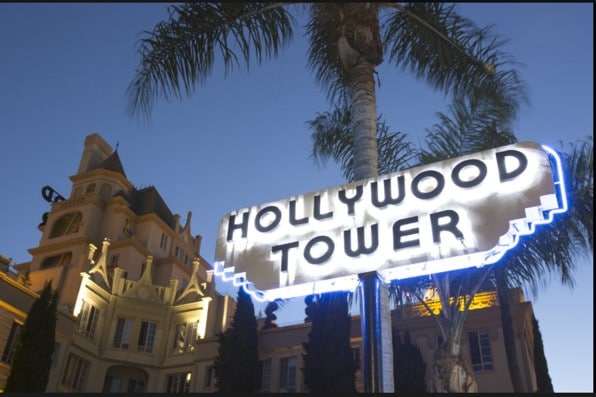
Source: Abado.com
Its large neon “Hollywood Tower” sign from the side of the building can be seen clearly from the northbound lane of the Hollywood 101 Freeway. It has been cited with its sign and the ascending design of the central building (only seven stories high) as one of the inspirations for the exterior of Florida’s Twilight Zone Tower of Terror attraction. The building gets ample screen time in the Disney comedy Midnight Madness (1980) and was a well known Hollywood landmark.
Speaking of screen time, Tower of Terror shown on October 26, 1997 on ABC’s The Wonderful World of Disney weekly television program was the first film based on a Disney theme park attraction. While it was primarily filmed in Hollywood, some of it was filmed at the attraction in Orlando, Florida.
The roughly ninety-minute movie was written and directed by D.J. McHale who had previously worked as a writer for the Encyclopedia Brown television series as well as several After School Specials and was the co-creator (with Ned Kandel), writer and director on the Nickelodeon tv series Are You Afraid of the Dark?
“I was never a horror fan but I loved scary stories like the compilations of short stories supposedly written by Alfred Hitchcock,” said McHale. “I felt Tower of Terror was really normal people you might know and that you feel like you could relate to, who are caught up in a bigger-than-life adventure. That’s what comes out of my head, I don’t know why, but that’s what comes out.”
The story has only the slightest connection to the storyline of the actual attraction and no reference to the Twilight Zone.
Disgraced reporter Buzzy Crocker (Steve Guttenberg) was fired from the Los Angeles Banner newspaper for submitting a story that turned out to be false. He now works for a sleazy supermarket tabloid called The National Inquisitor assisted by his young niece Anna (a very young Kirsten Dunst).
An elderly woman named Abigail Gregory comes to Buzzy with a story about an incident she witnessed at a now abandoned luxury hotel back in 1939 where five hotel guests mysteriously disappeared. Gregory claims that the nanny of child film star Sally Shine was a witch who cast a curse that backfired. Buzzy feels that if the story is true he might be able to get a job on a legitimate newspaper.
The elevator has been repaired, and using items from the people who had disappeared, an attempt is made to free the ghosts from their curse. However, it turns out that Abigail is actually the jealous sister of Sally and is the one who cast the original curse. Fortunately the two reconcile before everyone is doomed for all eternity.
The other ghosts ascend to the Tip Top Club in all its former glory and then go on to Heaven along with the other party attendees who had also been trapped. With the curse broken, the Hollywood Tower Hotel is restored and re-opened.
It is not surprising that this made-for-television movie is little remembered but it is also another entry on the list of Walt Disney World appearances on film.
* * * * *
Thanks, Jim! And come back next Friday for more from Jim Korkis!
In the meantime, check out his books, including his soon-to-be released Vault of Walt Volume 9: Halloween Edition, and Hidden Treasures of the Disney Cruise Line.
Follow yourfirstvisit.net on Facebook or Twitter or Pinterest!!
October 2, 2020 No Comments
A Friday Visit with Jim Korkis: The Wonderful World of Disney Television
Welcome back to Fridays with Jim Korkis! Jim, the dean of Disney historians, writes about Walt Disney World history every Friday on yourfirstvisit.net.
YOUR PERSONAL DISNEY LIBRARY (32)
By Jim Korkis
- The Wonderful World of Disney Television by Bill Cotter
Do you fondly remember the Walt Disney World Celebrity Circus show hosted by Tony Randall that ran on NBC in 1987? Or how about the 1993 syndicated Walt Disney World Journey Into Magic that took a look at many attractions at WDW? Or Kraft Salutes Walt Disney World’s 10th Anniversary that aired on CBS in 1982?
Some of these dozens and dozens of shows only ran once with perhaps one rerun that same year. Some weren’t even on one of the three major networks but were syndicated just in local markets.
After all, the shows presented things that no longer exist at the world’s most popular vacation destination or didn’t showcase popular new additions to WDW so they were quickly considered outdated. If you don’t know the shows even exist or their names and dates, then how can you even begin to try to find them on YouTube or elsewhere?
The Wonderful World of Disney Television: A Complete History is one of the valuable reference books I frequently use when writing articles. In fact, it is still the only resource for Disney television shows. It needs updating and expansion but no one has risen to the occasion to do so and probably never will.
Filled with little-known details, anecdotes, and vital statistics, the book has chapters that fully describe each of the Walt Disney television shows from the anthology series to the Mickey Mouse Club to Zorro to Mouse Factory to Touchstone series and much more. It includes complete schedules of aired episodes, seasonal highlights, production details, behind-the-scenes stories, full cast and crew listings, and plot synopses and much more including fascinating introductory essays for each chapter.
Cotter has his own website and on it, he explained about his book: “During the years I worked for Disney (1976 -1982) I put together a number of employee presentations on the company’s old television shows, using that as an excuse to get these shows out of the vault so I could see them again myself.
“I researched the history of the show to help in introducing them, often tracking down some of the original cast and crew. As time went by I got to be known as the ‘old TV show guy’ and got calls from across the company asking for information.
“The calls continued even after I left Disney making me think there just might be enough interest in the shows for a book. Happily I was eventually able to convince Disney that there was, and they gave me complete access to the Disney Archives.
“After literally years of watching all of the episodes, the result was The Wonderful World of Disney Television, which was released in 1997. When I started writing my book I had no idea what a herculean task it was going to be, or how many pages the book would be. When I finished it turned out I had a little problem. Disney was thinking about a 300 page book. I wrote 1,100 pages.”
Thankfully, that extra material was not lost but perhaps many people don’t know how to obtain it.
Cotter continued, “Thanks to a wonderful editor (Monique Peterson) we ended up with a reasonable compromise, 635 pages. While I would have loved to see all it in print, some of the text had to go to get the book to a salable size. Happily I retained the copyright to the unused material, and have included it in a CD.”
That CD has fifteen appendices covering a bibliography, shows that never were, publications, awards and more. In Adobe Acrobat PDF format, there’s a full 256 pages of material for less than twenty dollars including postage. Cotter is also willing to ship it electronically and save the purchaser postage cost. If you are interested, go here.
Because the information is timeless, even though the book has been around for over two decades, the material remains accurate and helpful. As I said, I consider it a valuable reference volume in my own personal library.
* * * * *
Thanks, Jim! And come back next Friday for more from Jim Korkis!
In the meantime, check out his books, including his latest, Disney Never Lands, and about planned but unbuilt concepts, and Secret Stories of Walt Disney World: Things You Never You Never Knew, which reprints much material first written for this site, all published by Theme Park Press.
Follow yourfirstvisit.net on Facebook or Twitter or Pinterest!!
September 25, 2020 No Comments
A Friday Visit with Jim Korkis: Here Come the Muppets
Welcome back to Fridays with Jim Korkis! Jim, the dean of Disney historians, writes about Walt Disney World history every Friday on yourfirstvisit.net.
HERE COME THE MUPPETS
By Jim Korkis
With the premiere of a new Muppets television show, it is important to remember that Disney’s association with producing shows featuring the Muppets goes back a couple of decades.
In the late 1980s, legendary puppeteer Jim Henson had tired of having so much of his time devoted to business matters. He was in final negotiations with The Walt Disney Company to sell the rights to his famous Muppet characters and become a creative consultant just before his untimely death.
It looked so much like a completed deal that Henson was already at work on a variety of projects for Disney, including theme park attractions featuring the Muppets. In fact, there were plans for an entire new land to be called Muppet Studios with attractions, a restaurant, shops and more at Disney’s MGM Studios.
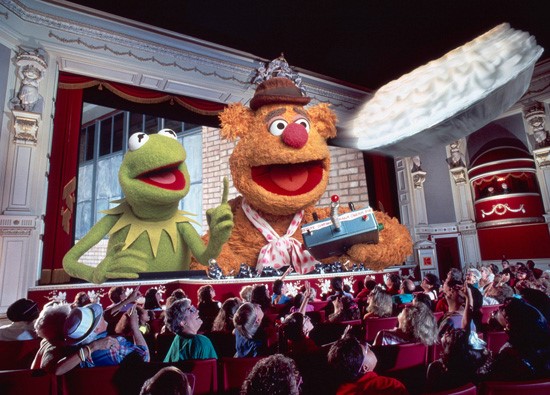
(c) Disney
While work was still proceeding on the major Muppet*Vision 3-D attraction, to help introduce the characters into the park, the fifteen minute stage show Here Come the Muppets was quickly opened in May 1990 in the theater in the Animation Courtyard that later housed The Voyage of the Little Mermaid.
To save time and money, the characters were portrayed by full-sized costumed performers with moving mouths, rather than puppets, except for two video inserts during the production.
The pre-show featured a video of the dog Rowlf playing the piano and being interrupted by Sam the Eagle.
Kermit is onstage and concerned because the other Muppets are late for the show. He receives a call on a videophone from Mickey Mouse who is checking in to see how things are going and Kermit lies that everything is fine. The scene with Mickey features the same set and animation as the Mickey scene in The Muppets at Walt Disney World television special from May 1990, but with different dialog.
Kermit calls the WDW picture phone operator who turns out to be actress Lily Tomlin doing her Ernestine character from Laugh-In. He asks to be connected with Miss Piggy who is relaxing in a robe and with mud on her face. Informed that she is on a videophone, she panics and instantly gets ready.
Kermit phones Fozzie Bear who claims to be lost but Kermit directs him to a green door behind him and it leads him to the stage.
Fozzie tells Kermit that Dr. Teeth and the Electric Mayhem band will be arriving soon by monorail,l and the front of a WDW monorail crashes through on stage right and the characters disembark. That same mechanism was later used for Ariel sitting on a rock in The Voyage of The Little Mermaid, to move it on and off stage.
The show now starts with the Muppets performing the songs: Make ‘Em Laugh (Kermit/Fozzie), Personality (Miss Piggy), Bein’ Green (Kermit), The Heart of Rock & Roll and Shout!
The prerecorded voice track for the show uses all the main Muppeteers: Jim Henson, Frank Oz, Dave Goelz, Richard Hunt, Jerry Nelson and Steve Whitmire. In addition, there were two filmed video inserts of Frank Oz voicing and performing Fozzie and Miss Piggy. That video footage was reused in the PBS series Great Performances episode entitled The World of Jim Henson in 1994.
Two weeks after the show closed on September 2, 1991, another show using full sized Muppet costumed characters premiered on a loading dock stage near the exit of Muppet*Vision 3-D entitled Muppets on Location: Days of Swine and Roses. The premise was that the Muppets were shooting a movie but take a break to interact with the audience by signing autographs and posing for photos. That show closed in 1994.
* * * * *
Thanks, Jim! And come back next Friday for more from Jim Korkis!
In the meantime, check out his books, including his latest, Disney Never Lands, about planned but unbuilt concepts, and Secret Stories of Walt Disney World: Things You Never You Never Knew, which reprints much material first written for this site, all published by Theme Park Press.
Follow yourfirstvisit.net on Facebook or Twitter or Pinterest!!
September 18, 2020 No Comments



